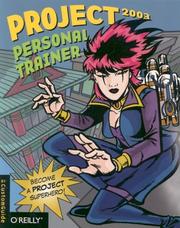Plan and Execute Projects Like a Pro
by CustomGuide
Successful projects require strategic planning that incorporates
balancing costs, resources, and deadlines. When a variety of details come into
play, you need the experience and support of the right tools and guidance. The
newest addition to O’Reilly’s Personal Trainer series, “Project 2003 Personal
Trainer” (CustomGuide, O’Reilly), is a hands-on guide with step-by-step
instructions along with an interactive CD that simulates the Microsoft Project
2003 environment.
Everything needed to execute projects successfully is covered in “Project 2003
Personal Trainer,” in an interactive format that provides feedback and guidance
for each session. Designed to teach professional skills in a simulated
environment, trainees can create sample projects and work at their own pace.
This book is for anyone interested in mastering project planning in
a learn-as-you-work environment with sessions specifically designed to tackle
the program in a comfortable setting, including:
-Fundamental Setup: Plan your project and schedule dates, working hours, and set
up a base calendar
-Enter and Work with Tasks: Add task duration, milestones, and organize in
phases
-Add and Assign Resources: Enter people, equipment and material resources,
assign to tasks, enter deadlines, and adjust schedules
-Work with Costs: Specify pay rates, fixed costs, and overtime rates
-Balance the Project: Identify resource over-allocation
-Checking and Updating Project Progress: Identify slipped tasks, check
variances, and review project’s critical path
-Produce Reports: Define report content, add page elements, and sort
-Work Multiple Projects: Create links between projects, consolidate, a resource
pool, and view critical paths for multiple projects
The Personal Trainer series is based on content from CustomGuide, a leading
provider of computer training materials. Founded by instructors who grew
dissatisfied with the industry’s dry course materials, CustomGuide offers
courseware for instructors and students, quick references, software bulletins,
and e-learning courses that are fun, flexible, and easy to use.
Table of Contents
About CustomGuide, Inc.
Introduction
About CustomGuide, Inc.
1. The Fundamentals Lesson 1.1
Planning the Project Lesson 1.2
Understanding Project Management Lesson 1.3
What’s New in Project 2003? Lesson 1.4
Understanding the Project 2003 Screen Lesson 1.5
Using Common Views Lesson 1.6
Using More Views Lesson 1.7
Creating a New Project Lesson 1.8
Entering the Project Scheduling Date Lesson 1.9
Selecting the Project Calendar Lesson 1.10
Adjusting Working Hours Lesson 1.11
Adjusting Working Days Lesson 1.12
Creating a New Base Calendar Lesson 1.13
Using the Project Guide Lesson 1.14
Printing a View Lesson 1.15
Printing the Current View as a Report Lesson 1.16
Getting Help
Chapter One Review
2. Entering the Task List Lesson 2.1
Entering Tasks Lesson 2.2
Estimating Task Duration Lesson 2.3
Entering Task Duration Lesson 2.4
Entering a Milestone Lesson 2.5
Organizing Tasks into Phases Lesson 2.6
Linking Tasks Lesson 2.7
Editing Task Links Lesson 2.8
Unlinking Tasks Lesson 2.9
Creating Recurring Tasks Lesson 2.10
Using the Task Information Dialog Box Lesson 2.11
Using Task Notes Lesson 2.12
Using Task Hyperlinks Lesson 2.13
Moving and Copying a Task Lesson 2.14
Inserting and Deleting a Task
Chapter Two Review
3. Entering and Assigning Resources Lesson 3.1
Entering People Resources Lesson 3.2
Entering Equipment Resources Lesson 3.3
Entering Material Resources Lesson 3.4
Adjusting Individual Resource Working Schedules Lesson 3.5
Using Resource Notes Lesson 3.6
Understanding Effort-Driven Project Scheduling Lesson 3.7
Assigning Resources to Tasks Lesson 3.8
Assigning Additional Resources to Tasks Lesson 3.9
Assigning Material Resources to Tasks
Chapter Three Review
4. Viewing the Project Lesson 4.1
Using Split Views Lesson 4.2
Sorting Information Lesson 4.3
Grouping Information Lesson 4.4
Filtering Information Lesson 4.5
Using AutoFilters Lesson 4.6
Viewing Details Lesson 4.7
Using Zoom
Chapter Four Review
5. Working with Tasks Lesson 5.1
Overlapping Tasks Lesson 5.2
Delaying Tasks Lesson 5.3
Setting Task Deadlines Lesson 5.4
Setting Task Constraints Lesson 5.5
Splitting Tasks Lesson 5.6
Understanding Task Type Lesson 5.7
Assigning a Task Calendar Lesson 5.8
Understanding Task Indicators
Chapter Five Review
6. Working with Resources Lesson 6.1
Delaying Resource Start Time Lesson 6.2
Applying Predefined Resource Contours Lesson 6.3
Specifying Resource Availability Dates Lesson 6.4
Grouping Resources Lesson 6.5
Assigning a Resource Calendar
Chapter Six Review
7. Working with Costs Lesson 7.1
Entering Resource Overtime Rates Lesson 7.2
Specifying Pay Rates for Different Dates Lesson 7.3
Adding Pay Rates for a Resource Lesson 7.4
Applying a Different Pay Rate to an Assignment Lesson 7.5
Using Material Resource Consumption Rates Lesson 7.6
Entering Task Fixed Costs
Chapter Seven Review
8. Balancing the Project Lesson 8.1
Scheduling Resource Overtime Lesson 8.2
Identifying Resource Overallocation Lesson 8.3
Balancing Resource Overallocations Manually Lesson 8.4
Balancing Resource Overallocations Automatically
Chapter Eight Review
9. Updating Project Progress Lesson 9.1
Saving a Baseline Plan Lesson 9.2
Updating Project Progress Lesson 9.3
Updating Task Actual Values Lesson 9.4
Updating Task Completion Percentage Lesson 9.5
Updating Actual Work Lesson 9.6
Updating Actual Costs
Chapter Nine Review
10. Checking Project Progress Lesson 10.1
Viewing Project Statistics Lesson 10.2
Viewing Project Costs Lesson 10.3
Viewing the Project’s Critical Path Lesson 10.4
Checking Duration Variance Lesson 10.5
Checking Work Variance Lesson 10.6
Checking Cost Variance Lesson 10.7
Identifying Slipped Tasks Lesson 10.8
Saving an Interim Plan
Chapter Ten Review
11. Working with Reports Lesson
11.1 Opening a Report Lesson
11.2 Adding Page Elements to a Report Lesson
11.3 Sorting a Report Lesson
11.4 Defining Report Contents Lesson
11.5 Saving a Project as a Web Page
Chapter Eleven Review
12. Working with Multiple Projects Lesson
12.1 Creating Links Between Projects Lesson
12.2 Consolidating Projects Lesson
12.3 Viewing Critical Paths for Multiple Projects Lesson
12.4 Viewing Consolidated Project Statistics Lesson
12.5 Creating a Resource Pool
Chapter Twelve Review

